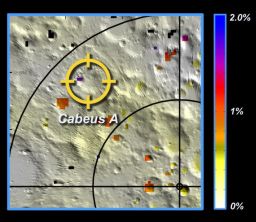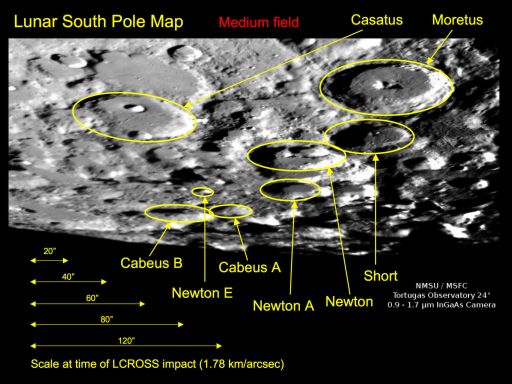Emily Lakdawalla • Sep 11, 2009
LCROSS Mission Selects Crater Cabeus A As Target for October 9 Impact
[I just posted this as a formal news story too.] NASA announced this morning that the Lunar Crater Observation and Sensing Satellite (LCROSS) mission has selected the target for its planned impact. The selected crater is Cabeus A, which is centered on the lunar nearside at 82.2 degrees south, 39.1 degrees west. The actual target site is offset from the crater's center to the north, within a permanently shadowed area. Data from Lunar Prospector suggests that the targeted part of the crater could contain as much as two percent water in the upper meter of soil.
"The selection of Cabeus A was a result of a vigorous debate within the lunar science community that included review of the latest data from Earth-based observatories and our fellow lunar missions Kaguya, Chandrayaan-1, and the Lunar Reconnaissance Orbiter," LCROSS project scientist and principal investigator Tony Colaprete said in a press release today. At the press briefing he stated that the world would know "within an hour" whether the mission was successful in producing a large plume of material from the impact site.
The LCROSS mission hopes that the plume will contain signs of elusive lunar water. The Lunar Prospector data shows the presence of hydrogen within this crater, but water is only one of many possible materials that could be the reservoir of that hydrogen, Colaprete said. "We know it's hydrogen. It could be water. It could be methane. Or hydrocarbons, or organics. Whatever the Moon has collected over the eons could be trapped" in the permanently shadowed craters near the poles. Colaprete said that even if it turns out not to be water, the mission would be a scientific success regardless of what it finds: "It's a time capsule. I see LCROSS and LRO combined as a gateway, a pathfinder for understanding the role of volatiles in the solar system."
The impact will be observed by several space-based observatories, including the newly refurbished Hubble Space Telescope; GeoEye, a private spacecraft that provides high-resolution satellite imagery; Odin, a Swedish radio astronomy satellite; NASA's Earth Observing 1 technology demonstration satellite; and LCROSS's sister mission Lunar Reconnaissance Orbiter. In addition, numerous professional ground-based telescopes will be watching, including Keck, Gemini, and IRTF in Hawaii; Magdalena Ridge and Apache Point Observatories in New Mexico, and MMT in Arizona. Earth-based observers have to be in local night, so Earth observations must be conducted from points approximately west of the Mississippi.
The LCROSS mission is also seeking substantial aid from the amateur astronomy community. Colaprete said that the impact should reach a maximum brightness of magnitude 5, possibly even magnitude 4 and that the period of maximum brightness should "last about 30 seconds and slowly fade as the ejecta cloud settles back to the surface." The event should be visible to well-placed observers with at least 10- or 12-inch telescopes. Detailed information about observing the LCROSS impact is available from the mission's Ames Research Center website.
Let’s Go Beyond The Horizon
Every success in space exploration is the result of the community of space enthusiasts, like you, who believe it is important. You can help usher in the next great era of space exploration with your gift today.
Donate Today

 Explore Worlds
Explore Worlds Find Life
Find Life Defend Earth
Defend Earth



